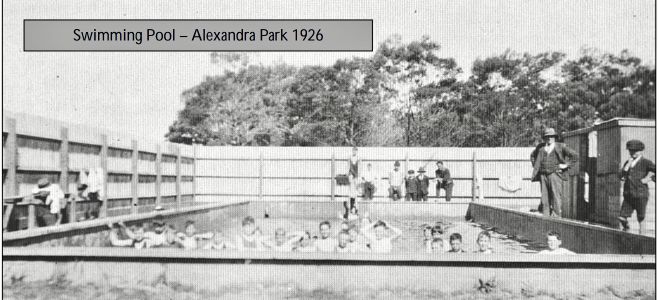Looking Back - Swimming
By Leo Billington
Is our national identity caught up in swimming?

Morwell’s first swimming pool was opened in 1925 in Alexandra Park beside the Bowling Green and the Band Hall, parallel to the railway line, about where the Skate Park is now located. This pool closed in 1954 when a new Olympic swimming pool was built in Sir Norman Brookes Park in McDonald Street on land supposedly donated by APM.
It seems that this convenient, though narrow open area was called “Alexandra Park”, no doubt so named after Queen Alexandra, consort of King Edward VII, although she never visited Australia.
The Olympic swimming pool in Sir Norman Brookes Park was built in 1956. Sir Norman Everard Brookes was an Australian tennis player. During his career he won three Grand Slam singles titles; Wimbledon in 1907 and 1914 and the Australasian Championships in 1911. Brookes was part of the Australasian Davis Cup team that won the title on six occasions.
In 1921, Brookes was appointed Chairman of Directors of the Australian Paper Mills Company. Perhaps here lies the story that land was donated for a new swimming pool. More about this aspect later.
In March 1903, the Morwell Advertiser drew attention to safe swimming by quoting an unnamed English journalist “that the English law should make swimming compulsory – the duty of parents and school teachers is clear.”
At a general meeting of the Morwell Progress Association on October 30, 1908, it was recommended that “procurement of swimming baths” be a high priority. One month later, and despite apparent unwillingness to acknowledge “Mirboo North’s greatness”, the Progress Association were humble enough to lobby for a local swimming pool.
Yet, on December 26, 1908, the Association decided to make a start on a local swimming pool. Volunteers lined up – “several were bringing horses and chains. All interested were asked to lend a hand in snagging etc.”
The volunteers met at the Morwell River, close to railway bridge, for the purpose of snagging and clearing the river for the benefit of the local swimmers, as well as those who were unable to swim, and were willing and anxious to learn. They provided horses, harness, ropes and chains which were very necessary for the purpose of removing sunken logs from the bed of the river, and, it was reported that “good work was done.”
Prior to 1925, there was plenty of community support for safer swimming baths. In October 1920, the Morwell North State School proudly announced their new teacher, Mr Keamy was extremely supportive of establishing swimming classes. In his previous teaching appointment at Barmah, he saved students from drowning, and subsequently was awarded a bronze medal of the Royal Humane Society of Australia.
In March 1923, at a state school picnic held at Blossom Flat, on the banks of the Latrobe River, some children were bathing in the river at a sand bank, when Ruby Douglas, of Brown Coal Mine, a girl about 14 years of age, who was unable to swim, got out of her depth, and was carried down the stream by the current. Ruby was saved, but only after considerable efforts from other children and adults.
A similar occurrence happened at the same spot a few years before during a school picnic, when, as local paper reported; “a local boy got out of his depth and would no doubt have been drowned but for the plucky rescue made by Master Frank Holmes, then only nine years of age, who swam in and saved the lad.”
For about 17 years, the Morwell Progress Association maintained their momentum to secure a location for safer swimming baths. Their work in 1909, as it was reported; “resulted in there being a rather fine swimming or bathing place, which will be further improved as soon as funds are available, by the erection of steps, spring-board, and a dressing room for ladies; it being contemplated to set apart two days in each week for their exclusive use. It is noted that Mr Donald Waldon played a key role in pushing for a safer location in Morwell.” (Mr Waldon’s son had also a very narrow escape from drowning in August 1887. The boy was trying to get a dog out of a large waterhole, when he fell in himself. Happily, he was rescued, but the dog was drowned.)
At the new swimming pool, the hours for children were fixed from 3.30 till 4.45; ladies only, Tuesday and Thursdays - 6 till 7pm. The baths to be closed on Sundays, from 9 am till 12 noon and from 6 till 8 pm. The pool was to be cleaned out and washed with lime. It was decided that baths be refilled with fresh water at frequent intervals.

To achieve an Olympic size pool for Morwell, during 1954, every family in Morwell and district was asked to donate £2 towards the £5,000 required from the public to build a £22,500 Olympic swimming pool. The pool appeal committee pledged itself to raise the £5,000 within a year.
Morwell, by 1954, seemed to lag behind in public amenities according to The Argus (31 August 1956). In editorial, Morwell was “a town that has had its population increased from just over 3,000 to nearly 12,000 in the last six years, is beginning to catch up on its amenities. Work began yesterday on an Olympic swimming pool that will cost £33,000. Already £24,000 is in hand, made up of public subscriptions, council contribution, and grants. It will be a 50-metre filtered pool with a waders' pool.”
(Ironically, Morwell was lagging behind in other aspects – after almost 10 years of arguing, in October 1952, it was announced that a new fire station would be built in Church Street. Similarly, during the same time, arguments surrounded a need for a dedicated ambulance station. Poor ol’ Morwell.)


